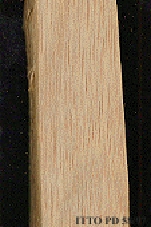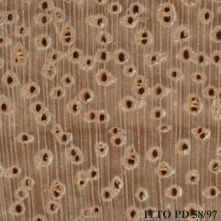
INGA, GUAVO (Inga edulis)
Trade Name
Inga, Guavo
Scientific Name
Inga edulis Mart.
Family
LEGUMINOSAE
Common Names
Pois doux; Inga cipo; Guayaniquil; Guavo; Guamo blanco; Pois Dous (Guyana); Guamo (Venezuela); Guaba (Peru); Guaba Mansa (Ecuador); Guamo (Colombia); Pacay (Bolivia); Inga (Brazil); Imburana (Brazil); Shimbillo (Peru); Caramacate; Guamo Negro; Churimito; Guamo Churimo; Guamo Hierrito; Maporokon; Guamo Colorado; Bois Pagode
Scientific Name Synonyms
Inga edulis var. grenadensis Urb.; Inga benthamiana Meisn.; Feuilleea edulis (Mart.) Kuntze
Description Of The Tree
Botanical Description
It is a small tree of about 20 m, with a trunk diameter that can reach 30 to 60 cm. The tree usually develops an irregular stem, with commercial lengths up to 16 m.
Natural Habitat
Inga edulis is a pioneer tree found in the secondary tropical and subtropical rain forests of tropical America. It prefers humid areas in low hills.
Natural Distribution
It is reported from Guyana, Venezuela and Colombia, south to Brazil, Peru and Bolivia.
Plantations Available?
It is commonly planted within its region of origin for its fruits.
Wood Identification
Anatomic Description Of Wood
Wood diffuse porous. Vessels solitary and in short radial multiples. Occasionally tangential diameter of vessel lumina 200 micras or more. Occasionally white deposits in heartwood vessels. Vessels per mm2 less than 6 (rare). Simple perforation plates. Vessel-ra Paratracheal axial parenchyma scanty and/or vasicentric. Axial parenchyma lozenge-aliform. Occasionally axial parenchyma confluent. Occasionally prismatic crystals in chambered axial parenchyma cells and/or in fibers. 3 to 4 cells per parenchyma strand. 4 to 10 rays per mm (medium). Rays exclusively uniseriate. Homogeneous rays and/or sub-homogeneous rays (all ray cells procumbent). Septate fibers present. Fibers with simple to minutely bordered pits.
-
 Wood Macro Photo Tangential Plane
Wood Macro Photo Tangential Plane
-
 Wood Micro Photo Of Transversal Section
Wood Micro Photo Of Transversal Section
Availability
Cites Status
Unrestricted
General Wood Description
Odor
It has no characteristic odor or taste.
Color
The sapwood is pale yellow, the heartwood gradually changes into a very pale brown.
COLOR INDEX (1=Black, 7=Light yellow,white)
5
Grain
This species is reported to have typically straight or interlocked grain.
Texture
The wood is mostly coarse in texture.
Luster
The wood surface is moderate in luster.
Natural Durability
This species is prone to wood staining fungi attack.
Natural durability index (1= Very high durability, 7=Vey low durability)
5
Internal Growth Stresses
Timber of this species contains residual stresses.
Resistance To Impregnation
It is reported to be moderately permeable, with good retention of oil and high retention of water based preservative substances.
Wood Physical Properties
Basic Density or Specific Gravity (O.D. weight/vol. green) (g/cm³)
0.57
Air-dry Density (Weight and volume at 12%MC) (g/cm³)
0.63
Total shrinkage Tangential (Saturated to 0%MC) (%)
8.4
Total shrinkage Radial (Saturated to 0%MC) (%)
3.8
Drying Defects
Ease of Drying: Slow air drying. It is considered to be moderately difficult to season. Drying Defects: Minor warping and checking are reported.
Dimensional stability ratio (Total Tangential Shrinkage %/Total Radial Shrinkage %)
2.2
Wood Chemical Properties
Wood Mechanical Properties
Bending Strength (MOR),12%MC (kgf/cm²)
876
Compression parallel to fiber 12%MC (kgf/cm²)
505
Janka hardness (side) 12%MC (kgf)
501
Workability
Sawing
Wood of this species is easy to cut.
Rotary Veneer Cutting
It is interesting for peeling.
Sliced Veneer
It is interesting for peeling.
Blunting Effect
It is considered to have a slight blunting effect on the cutting elements.
Machining
It is reported to be easy to process, but the finishing is rated as fair.
Planing
Planing operations are rather easy.
Moulding
It is easy to mold.
Turning
30
Nailing
Good nail-holding properties.
Gluing
It is reported to be easy to glue.
Finishing
Finishing of this wood is rated as fair.
REFERENCED USES
End Uses Summary
HOUSING GENERAL, fittings, PLYWOOD AND VENEER, TURNING, PACKING
General Housing
- 10 - Silica in Timbers
Fittings
- 19 - Silica in Timbers
Panels, Veneers
- 25 - Directory of Timber Trade Malaysia
Turning
- 30 - Embassy of Honduras in Japan
Packing
- 45 - Recopilación y Análisis de Estudios Tecnológicos de Maderas Peruanas
Please Provide Information To View Producer Information